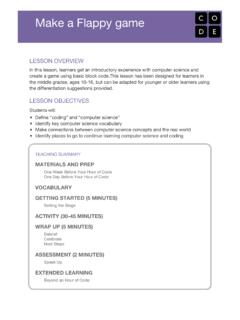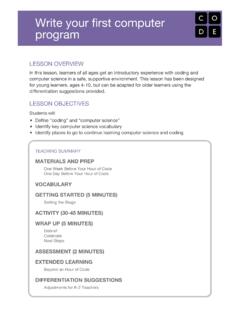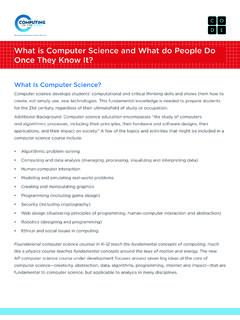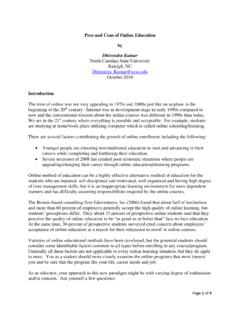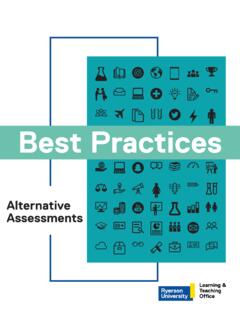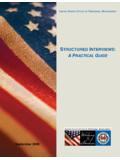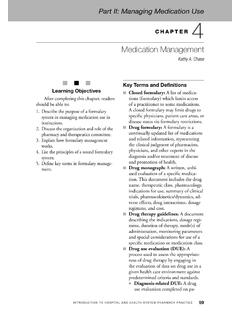Transcription of AP® Computer Science Principles - Code.org
1 Computer Science Principles Syllabus and Overview AP Computer Science Principles s Computer Science Principles (CSP) curriculum is a full-year, rigorous, entry-level course that introduces high school students to the foundations of modern computing. The course covers a broad range of foundational topics such as programming, algorithms, the Internet, big data, digital privacy and security, and the societal impacts of computing. All teacher and student materials are provided for free online and can be accessed at AP Endorsed is recognized by the College Board as an endorsed provider of curriculum and professional development for AP Computer Science Principles (AP CSP). This endorsement affirms that all components of CSP s offerings are aligned to the AP Curriculum Framework standards, the AP CSP assessment , and the AP framework for professional development.
2 Using an endorsed provider affords schools access to resources including an AP CSP syllabus pre-approved by the College Board s AP Course Audit, and officially-recognized professional development that prepares teachers to teach AP CSP. AP is a trademark registered and owned by the College Board. AP At-a-Glance The curriculum is divided into roughly 120 daily lesson plans which comprise 10 units of study. More detailed information about each unit can be found later in this syllabus. Unit 1 Digital Information Explore how computers store complex information like numbers, text, images and sound and debate the impacts of digitizing information. Unit 2 The Internet Learn about how the Internet works and discuss its impacts on politics, culture, and the economy.
3 Unit 3 Intro to App Design Design your frst app while learning both fundamental programming concepts and collaborative software development processes. Unit 4 Variables, Conditionals, and Functions Expand the types of apps you can create by adding the ability to store information, make decisions, and better organize code . Build apps that use large amounts of information and pull in data from the web to create a wider variety of apps. Unit 5 Lists, Loops, and Traversals Unit 6 Algorithms Design and analyze algorithms to understand how they work and why some are considered better than others. Unit 7 Parameters, Return, and Libraries Learn how to design clean and reusable code that you can share with a single classmate or the entire world.
4 Unit 8 Create PT Prep Practice and complete the Create Performance Task (PT). Unit 9 Data Explore and visualize datasets from a wide variety of topics as you hunt for patterns and try to learn more about the world around you. Unit 10 Cybersecurity and Global Impacts Research and debate current events at the intersection of data, public policy, law, ethics, and societal impact. 1 Computer Science Principles Syllabus and Overview Our Vision s vision is that every student in every school should have the opportunity to learn Computer Science ( ). Our curriculum is designed so that an empowered teacher can lead a diverse group of students through experiences that are supportive, equitable, engaging, and lead to valuable learning ( ).
5 Historically this vision has contrasted sharply with reality. Until recently, most schools did not offer Computer Science at all, and what classes there were notoriously lacked in diversity. Additionally, many students found these classes unengaging, intimidating, or simply disconnected from their lived experiences with technology. Thanks to efforts by many organizations and individuals, this world is beginning to change: many more schools now offer Computer Science courses; more diverse students take those courses; and more engaging, relevant, and equitable pedagogy has become the established norm. Even so, there is much work still to be done. This course is designed to continue this momentum as the collective CS education community moves towards this vision of an equitable CS education system.
6 How We Support Our Vision Many aspects of s CS Principles curriculum are designed to bring about the eventual change we aim to see more broadly in CS education. Some of the most significant features are listed below. Free and open: We make our curriculum, videos, and tools free and open for anyone to adopt. Prioritize New-to-CS Teachers: Historically only a few schools could hire trained Computer scientists as teachers, which severely limited which schools could offer a CS course. Reaching all schools has meant developing our CS Principles course with the understanding that most of our teachers are new-to-CS and prioritizing their needs. As such, our course includes some distinctive features. Comprehensive lesson plans and resources designed to ensure new-to-CS teachers have everything they need to implement the course Clear and consistent pedagogy to help new-to-CS teachers develop best practices as CS teachers High-quality videos that help teachers introduce and explain CS concepts An associated professional learning program that pays particular attention to the needs of new-to-CS teachers Equitable Pedagogy: Our curriculum is designed to promote an equitable classroom environment for all students, with particular attention paid to the experiences of historically excluded groups, most notably young women and students from underrepresented minorities in computing.
7 Drawing from extensive feedback from our classrooms, as well as CS education research, our course includes many features designed to support and prioritize these students: Pedagogy that develops a collaborative and supportive classroom environment Specific attention paid to language demands of our lessons Projects and activities that highlight a variety of applications of computing and frequently ask students to incorporate their own backgrounds and interests. A sequencing of topics that intentionally delays the introduction of programming (the CS topic with which privileged groups are most likely to have prior experience) Curriculum videos that feature a cast of diverse role models in terms of race, gender, and profession who empower our diverse students to see themselves as part of the world of computing A professional learning program that highlights these features and helps teachers reflect on how best to implement them within their own classroom Join Us in this Vision We think our vision is audacious and deeply motivating.
8 If you feel the same, the best way to join us in this vision is to teach this course! We know that for many teachers this represents a significant undertaking, and we have aimed to do our best to help share the load. Based on the feedback of many teachers we know it will be a challenging, but ultimately gratifying experience. is here to support you, and we look forward to your feedback so that we can continue to make CS Principles an even better experience for our students and teachers. 2 Computer Science Principles Syllabus and Overview Provided Materials The curriculum provides a comprehensive set of resources for the teacher, including detailed minute-by-minute lesson plans for every day of instruction, engaging activities and projects, formative and summative assessments, computing tools that are designed for learning specific concepts, and the programming environment, App Lab.
9 These resources have been specifically curated for each step of each lesson and help provide a unified experience. Together, these resources typically allow the teacher to act in the role of facilitator and coach when addressing unfamiliar material. In instances when the teacher acts as the primary source of information, generous supports are provided. All resources below can be accessed free of charge at Lesson Plans Instructional guides for every lesson Activity Guides and handouts for students Unit presentation slides Formative and summative assessments Exemplars, rubrics, and teacher dashboard Videos Tutorials, instructional videos, and inspirational videos Tools Widgets - designed for exploring individual computing concepts Internet Simulator - s tool for investigating the various layers of the internet App Lab - s JavaScript programming environment for making apps Technical Requirements The course requires and assumes a 1.
10 1 Computer lab or setup such that each student in the class has access to an Internet-connected Computer every day in class. All of the course tools and resources (lesson plans, teacher dashboard, videos, student tools, programming environment, etc.) are available online. Tablets are not currently supported. For more details on the technical requirements, please visit: While the course features many unplugged activities designed to be completed away from the Computer , daily access to a Computer is essential for every student. The course is developed to be completed within the classroom - no homework or after-hours Computer access is assumed. Required Materials and Supplies Lessons make use of common classroom materials such as: Student journals or notebooks Poster paper Markers Post-it notes Plastic baggies Suggested substitutions can be found in individual lesson plans.




